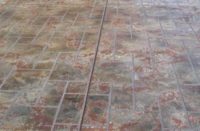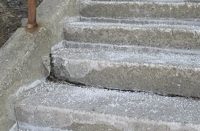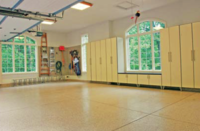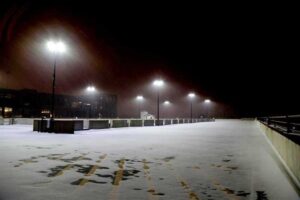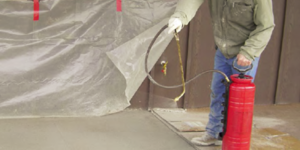
Known for its unique designs and artistic appeal, decorative concrete is a popular material in modern construction projects. Whether it’s a stamped driveway, a stylish patio or an intricate walkway, decorative concrete adds both functionality and visual interest to any space.
However, like all materials, decorative concrete is subject to wear and tear—particularly from rain, snow, UV radiation and other weather phenomena. Without proper weatherproofing, this exposure can lead to water damage and gradual deterioration. Over time, this can significantly impact the appearance, durability and longevity of the structure.
The following are some of the common risks posed by weather on decorative concrete, why weatherproofing matters, and effective methods for safeguarding these surfaces against damage.

decorative concrete
Common Risks Posed by Weather-Related Factors
While concrete is highly durable, it’s also a porous material. It can absorb moisture from rain, snow or humidity. Over time, the infiltration of water can cause significant damage. A major risk factor is the corrosion of steel reinforcement embedded within the concrete. When moisture reaches the steel, it can initiate rusting. This corrosion of steel leads to expansion, which exerts internal pressure on the surrounding concrete. Over time, this can result in cracking, spalling and a compromised structure that loses both
strength and aesthetic value.
Another common issue arises from freeze-thaw cycles, which are particularly problematic in climates with seasonal temperature changes. As water penetrates the concrete, it freezes and expands during cold temperatures, causing the concrete to crack and the surface to scale. This repeated freezing and thawing can cause significant surface deterioration, detracting from the beauty of decorative finishes like
stamped patterns, colored stains or exposed aggregate.
Efflorescence—a white, powdery salt deposit left behind by migrating moisture—is another problem that is often weather related. Efflorescence is more of an aesthetic issue than a structural one. It can mar the structure’s intricate designs and overall appearance.
Persistent moisture can also encourage the growth of mold and mildew on the concrete’s surface. This not only affects the appearance but can pose health risks if not addressed promptly. In warmer climates, UV rays from the sun can also cause fading of decorative stains and sealers, further diminishing the visual appeal of the concrete. Ultimately, without proper weatherproofing, the long-term durability and beauty of the product can be severely compromised. From the corrosion of internal steel reinforcement to surface cracking and spalling, the effects of water damage are far-reaching.
This, in turn, makes decorative concrete prone to frequent damage that requires repair or even resurfacing of the concrete. Weatherproofing significantly reduces the likelihood of such deterioration, saving property owners from the expense and effort of constant upkeep.

Best Methods for Weatherproofing Your Decorative Concrete
Several methods exist for weatherproofing decorative concrete, each offering unique benefits based on project needs and environmental conditions. Among the most reliable and widely used are integral crystalline admixtures, silane-based repellents and siloxane-based repellents.
Whether applied during the mixing process or as a post-construction treatment, each of these weatherproofing techniques serve to safeguard your decorative concrete against water infiltration and weather-related damage while preserving its natural beauty.
Integral Waterproofing with Crystalline Admixtures
One of the most sophisticated methods of weatherproofing is the use of integral crystalline admixtures. These are added directly into the concrete mix during the batching process, ensuring the entire structure benefits from uniform protection. Crystalline admixtures work by reacting with moisture and by-products of the cement hydration process, forming insoluble crystals that fill the capillaries, pores and cracks within the concrete surface. These crystals effectively block any potential pathways for water infiltration, providing a permanent waterproofing solution from the inside out.
This method is particularly advantageous for decorative concrete because it does not alter the surface appearance, protecting even the most intricate designs, textures and colors. Additionally, because the waterproofing is integrated into the concrete itself, this is a long-lasting solution that requires minimal maintenance over time.
Silane-Based Water Repellent Treatments
Another effective solution for weatherproofing decorative concrete is silane-based water repellents. These treatments work by penetrating deeply into the concrete and forming a permanent bond with the silica within the material. This bond creates a hydrophobic layer that repels water while allowing the surface to
maintain its natural appearance.
Silane-based water repellents are particularly ideal for dense, non-porous surfaces such as polished or stamped decorative concrete. They offer invisible protection, allowing the treated surface to retain its original look while repelling moisture and contaminants.
One of the major benefits of silane-based treatments is their durability. They penetrate deeply into the concrete, providing long-lasting protection against water damage, salt corrosion and freeze-thaw cycles. This makes them an excellent choice for exterior decorative concrete that is exposed to harsh environmental conditions.
Siloxane-Based Water Repellent Treatments
Although siloxane-based water repellents function similarly to silane-based treatments in many ways, they are much more suitable for medium-porosity surfaces. Like with silane, siloxane forms a hydrophobic layer on the concrete surface, preventing water from penetrating while preserving the material’s appearance and durability.
Siloxane-based treatments are versatile and can be used on a variety of materials beyond concrete, including brick and stucco. This makes them a flexible option for projects that combine multiple materials, ensuring consistent protection across the entire structure.
In addition to their versatility, siloxane-based water repellents are typically more cost-effective than silane-based options. This makes them a practical choice for large-scale projects or installations where budget constraints are a key consideration.
Acrylic Sealers for Surface-Level Protection
A less effective, but still viable, option is acrylic sealers. This treatment is often applied to decorative concrete to enhance appearance and provide surface protection, but does not offer true waterproofing. While acrylic sealers form a protective film that helps guard against UV rays and light moisture, they primarily act as a surface barrier and wear down over time—especially in high-traffic areas. Unlike penetrating sealers, which absorb into the concrete to create a deeper, more durable moisture-resistant barrier, acrylic sealers are less effective at long-term weatherproofing and preventing water infiltration.
That said, acrylic sealers do offer aesthetic benefits, enhancing the vibrancy of decorative finishes and providing a glossy or matte finish depending on the product. Acrylic sealers are a good option for areas that need short-term protection and visual enhancement, though they should be re-applied periodically to maintain their effectiveness.
From integral crystalline admixtures that offer long-lasting internal protection to silane- and siloxane-based treatments that shield the concrete surface while maintaining aesthetic appeal, multiple waterproofing methods exist to meet the needs of any decorative concrete project.
With the right weatherproofing techniques in your toolkit, decorative concrete can tackle the challenges posed by water, weather and time. These protective measures not only enhance the longevity of the decorative concrete installations but contribute to their overall performance—ensuring that they remain visually striking and structurally sound for years to come.
